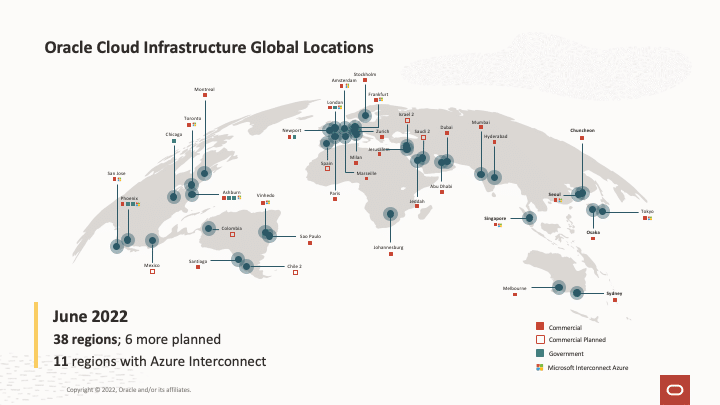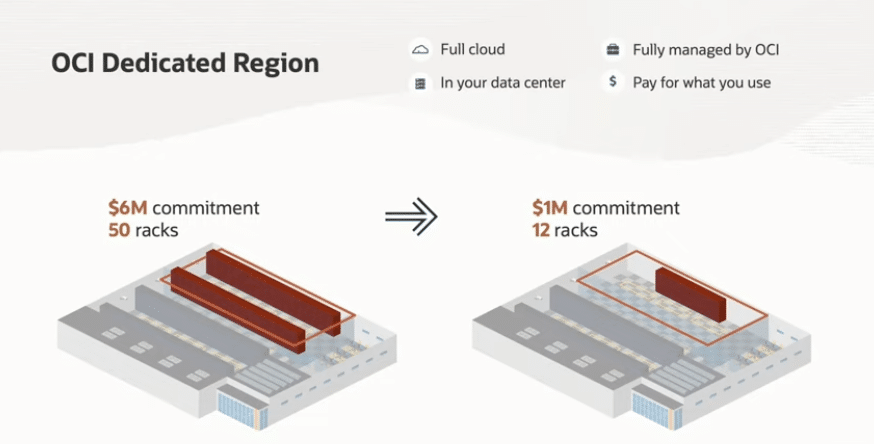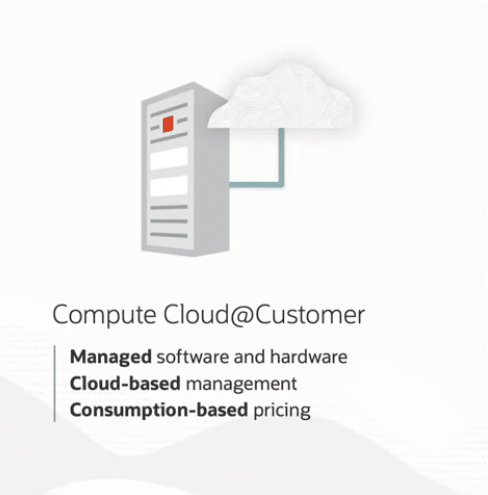Oracle has introduced a lower entry point for Oracle Cloud Infrastructure (OCI) Dedicated Region and a preview of Compute [email protected] services. OCI Dedicated Regions delivers the full public cloud to customer data centers with a new, smaller footprint and lower price. The new services help customers meet strict latency, data residency, and data sovereignty requirements.
Oracle has introduced a lower entry point for Oracle Cloud Infrastructure (OCI) Dedicated Region and a preview of Compute [email protected] services. OCI Dedicated Regions delivers the full public cloud to customer data centers with a new, smaller footprint and lower price. The new services help customers meet strict latency, data residency, and data sovereignty requirements.

OCI Dedicated Region is a complete cloud region in the customer’s data center, offering the agility, scalability, and economics of OCI’s public cloud while retaining data and service control. With an OCI Dedicated Region, customers can start small and build quickly, with a lower minimum consumption commitment paying for only the services consumed. The predictable pricing is the same as those available in Oracle’s public regions with no up-front costs.
OCI Regions get significant enhancements
Oracle has made significant technical and operational enhancements to the OCI solution, such as:
- A smaller base footprint to improve performance and reduce overall costs, with a 60% reduction in space and power requirements compared to prior versions using the latest high-density hardware supported by Intel and AMD, with HPC and GPU support for customers who need it. Dedicated Regions architecture, like OCI’s public cloud, is designed to maintain hardware and software redundancy requirements to implement three independent fault domains.
- Support for multiple dedicated regions, creating a private, dedicated cloud realm. Dedicated Regions have multiple interconnection options for connectivity between regions and can have public internet access if desired.
- Engineered to have layered security controls at all levels (Physical, Infrastructure, Application, and Data security coupled with enhanced automated observability), together with certifications such as HIPAA and PCI DSS now included in the base compliance.
- Increased flexibility in how the infrastructure is installed and expanded, allowing customers to start quickly and scale rapidly. This flexibility results from OCI managing capacity and expanding as necessary using the same infrastructure components used in Oracle’s public cloud regions.
Capabilities to benefit customers
The latest release of Dedicated Region also offers key capabilities to benefit customers while meeting data residency and low-latency requirements. These capabilities include:
- Access to all Oracle Cloud Infrastructure (OCI) services and Oracle Cloud Applications – OCI Dedicated Region allows customers to run existing enterprise applications and Oracle applications as well as build new, innovative functionality. Unlike typical on-premises solutions, Dedicated Region provides all the services and applications of OCIs public cloud.
- Independent, single-tenant cloud region in a customer data center – OCI Dedicated Region operates independently. All systems, including the control plane, are on-premises and managed remotely by OCI. Customers maintain control, security, and privacy with a single-tenant solution. Dedicated Region satisfies data residency or regulatory requirements to keep data within a jurisdiction and technical requirements such as low-latency connections to other infrastructure or facilities.
- Managed hardware and software solution – Customers benefit from the full functionality, supportability, and updates of hardware and software used by OCI’s public cloud regions.
- Delivered and supported as a service – Dedicated Regions are operated and supported by OCI, upgraded with new functionality when OCI cloud regions are updated, and backed by the same availability, manageability, and performance SLAs as OCI cloud regions.
Lower entry point for OCI Dedicated Regions
On average, the new OCI Dedicated Region requires 60-75% less data center space and power, with a significantly lower entry price of around $1 million a year for a typical customer. A wider range of customers can now gain the agility, economics, and scale of the public cloud in their data centers. Dedicated Regions can also be extended (like Oracle’s public cloud regions) in hybrid architectures using Roving Edge Infrastructure.

OCI Compute [email protected]
Oracle is also previewing OCI Compute [email protected], a rack-scale solution meant for smaller environments than the typical OCI Dedicated Region. Compute [email protected] will enable organizations to run applications on OCI-compatible compute, storage, and networking in their data centers, fully managed as a service from an OCI Region and using OCI’s consumption model to streamline operations and reduce costs.

With OCI Dedicated Region, Exadata [email protected], and Compute [email protected], organizations use the same OCI-managed hardware and software in their data centers and OCI Regions. Developers and IT managers will utilize the same APIs and management tools to create a consistent user experience, irrespective of where services run. Organizations can more easily develop, deploy, secure, and manage a single set of software across a wide range of distributed cloud environments.
OCI’s Distributed Cloud strategy brings services where customers need them
The OCI Region is operated as a commercial and government public cloud in 38 regions and can be interconnected with other clouds for multi-cloud architectures. Additionally, the OCI Region can act as the control plane for hybrid cloud offerings. The OCI Region can also be deployed in the customer data center as a dedicated, single-tenant cloud in a repeatable way.
OCI’s deployment options can include the functionality of all 100+ OCI services, or just a subset, with the required location choice, performance, security, compliance, and operational models. Together these deployment options comprise OCI’s distributed cloud.
Vodafone to migrate large number of systems to OCI Dedicated Region
Oracle and Vodafone have announced a strategic partnership to modernize the operator’s European IT infrastructure and accelerate its transition to the cloud. Under the multi-year agreement, Vodafone will modernize and migrate many of its systems to OCI Dedicated Region into Vodafone’s network and data centers. This will provide a dedicated cloud platform for Vodafone to modernize its thousands of Oracle databases as well as support and scale mission-critical OSS and BSS systems, including CRM and order management.
Vodafone expects to build new cloud-based applications faster by taking advantage of the geographical scale and simultaneously launching those applications in multiple markets.
OCI Dedicated Region will deploy in Vodafone’s main data centers
OCI Dedicated Regions will be deployed in Vodafone’s main data centers that manage its European IT and network operations. By deploying public cloud services inside Vodafone’s network and data centers, the carrier can flexibly modernize, manage, and automate critical systems using technologies such as autonomous services while meeting the applications’ latency and performance requirements.
Close access to compute resources enables Vodafone to dynamically augment and scale services in multiple geographies determined by changing business requirements while reducing operational costs and meeting residency regulations.
The partnership supports Vodafone’s multi-year initiative to consolidate and modernize the technology infrastructure that supports its mission-critical systems into a shared, on-premises, open-standard platform capable of supporting and scaling next-generation digital services. It will also help Vodafone further its Tech 2025 goals: reducing the time-to-market of its services, providing stand-out customer experiences through always-on services, and reducing operational costs through automation.
Nomura Research Institute (NRI) implements second OCI Dedicated Region
Following the successful adoption of the initial OCI Dedicated Region at its Tokyo data center, Nomura Research Institute (NRI) has implemented a second OCI Dedicated Region at its Osaka data center. Running on Oracle Cloud Infrastructure (OCI), NRI built a service platform and disaster recovery environment at the Tokyo and Osaka sites for the company’s T STAR asset management solution. Recognized as an industry-standard asset management infrastructure service and used by over 100 of the largest mutual funds and investment firms in Japan, T-STAR supports back-office processes and front-office operations. NRI is now running two of its most critical applications on OCI Dedicated Regions: BESTWAY and T-STAR.
With this implementation, NRI is one of the first companies in the world to automate its build process with OCI Dedicated Region. OCI helps NRI meet stringent regulatory, data sovereignty, and application latency requirements, including providing SOC2 reports based on Japanese security standards in the financial services industry. NRI benefits from
OCI’s high-performance, security, and scalability, in addition to a wide-band, low-latency, high-speed private network connection between NRI’s two dedicated regions, enables a disaster recovery capability that will keep regulated data within national borders.
With the deployment of the second OCI Dedicated Region, NRI can now shift its resources previously used for private cloud operations and maintenance to strategic areas such as digital transformation. NRI also plans to modernize its core financial SaaS applications by researching application development methods using Oracle Application Express and improving application development lifecycles using Oracle Container Engine for Kubernetes.
More info at OCI’s Website
Engage with StorageReview
Newsletter | YouTube | Podcast iTunes/Spotify | Instagram | Twitter | Facebook | TikTok | RSS Feed
